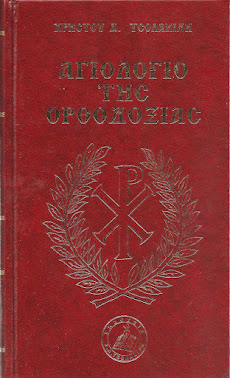Αναζήτηση αυτού του ιστολογίου
Σάββατο 9 Μαρτίου 2024
"Take, eat: this is my body, broken for you for the remission of sins."
"Take, eat: this is my body, broken for you for the remission of sins."
SPIRITUAL OVEN
In classical times, a κλίβανος was a covered earthen vessel, wider at the bottom than at the top, used for baking bread. A fire was lit within, after which the bread was baked from the radiant heat remaining in the vessel. “If then God so clothe the grass, which is to day in the field, and to morrow is cast into the oven (κλίβανος); how much more will he clothe you, O ye of little faith?” (Luke 12:28)
In the Homily in Praise of Mary the Theotokos, attributed to Epiphanius of Cyprus, the κλίβανος is seen as a figure of the Virgin Mary and the Holy Eucharist.
Χαῖρε, παναγία Παρθένε, ἡ τὸ πῦρ τῆς θεότητος ἀφλέκτως, ὡς νοερὰ βάτος, κατέχουσα, ἡ νοερὰ κλίβανος, ἡ τὸ πῦρ καὶ τὸν ἄρτον τῆς ζωῆς θερμὸν τῷ κόσμῳ πρὸς βρῶσιν ἐνέγκασα· περὶ οὗ λέγει ὁ Σωτὴρ τοῦ κόσμου Χριστός· Λάβετε, φάγετε· τοῦτό μου ἐστὶ τὸ σῶμα, τὸ ὑπὲρ ὑμῶν κλώμενον εἰς ἄφεσιν ἁμαρτιῶν.
Rejoice, O all-holy Virgin, spiritual bush containing the fire of the Godhead without being burnt, spiritual oven, having borne the fire and the warm bread of life for food for the world, concerning which Christ the Saviour of the world saith: Take, eat: this is my body, broken for you for the remission of sins.
From Fr. Justin's Sinai Blog: https://www.fatherjustinsblog.info/archives/8482
-------------------------------------
Christians came to Mount Sinai in the latter third century, fleeing from the Roman persecutions, even as Moses had come, fleeing from the wrath of Pharaoh. But the latter third and early fourth centuries also witnessed the beginnings of the monastic movement, when monks first began to seek out places in the desert, to pass their lives in prayer and fasting.
The earliest description refers to the Monastery of the Holy Virgin, for the revelation of God at the Burning Bush was seen as a type of the Virgin Mary and the Incarnation. The majestic basilica of today’s Monastery was subsequently built in honor of the Transfiguration of Christ, which reflects the special reverence of the Sinai brotherhood for the holy Prophets Moses and Elias, who both came to this mountain and later spoke with Christ at His Transfiguration. After Saint Catherine's relics were found nearby, the Monastery gradually became known simply as St. Catherine’s, without however losing its earlier dedications.
The architecture of the Sinai monastery is a stone, mortar, and wood record of its existence over seventeen centuries. Fortified walls surrounding the Monastery enclosure were made from massive granite blocks at the command of the Emperor Justinian in the sixth century. The center of this historic ensemble is the aforementioned basilica with its ancient doors and ceiling beams, and famed mosaic of the Transfiguration of Christ in the apse over the holy altar. At the eastern end of the basilica is found the Holy of Holies: the Chapel of the Burning Bush. This is the site of God’s revelation to Moses. Before approaching the immaterial fire of the Bush, Moses was commanded to remove his sandals, and until today, no one may enter the chapel wearing shoes. In the fourth century, the pilgrim nun Egeria wrote, ‘There are many cells of holy men and a church on the spot where the bush stands, and this bush is still alive today and gives forth shoots.’ The bush still flourishes outside the chapel. ...
From https://www.mountsinaimonastery.org/monastery#overview
Εγγραφή σε:
Σχόλια ανάρτησης (Atom)










Δεν υπάρχουν σχόλια:
Δημοσίευση σχολίου